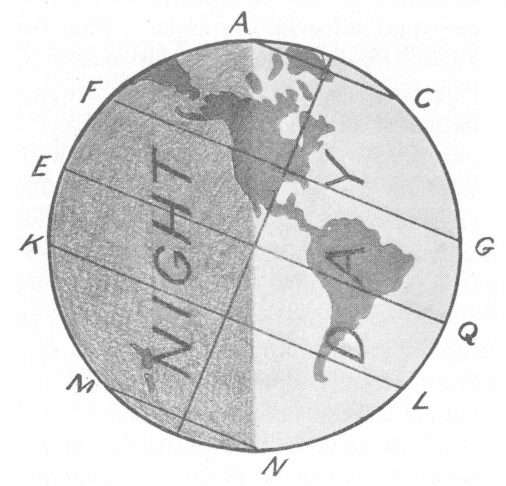 |
 |
 |
Let us now see how the sun shines on the earth at different times of the year.
Spring Position of the Earth. -- About the 21st of March of each year the earth is in the position A, figure 16, where the line from the sun to the earth is at right angles to the earth’s axis. The sun then illuminates the whole hemisphere of the earth which is turned toward it, from pole to pole. The days and nights are equal all over the earth. This time is called that of the Vernal Equinox, because the season in our hemisphere is spring, and the days and nights are equal.
Summer Position of the Earth. -- Three months later, about June 21, the earth will be in the position B, with the north end of its axis now tipped toward the sun. The sun then shines on the region round the north pole, while that round the south pole is in darkness, as we see by figure 17, which represents the earth in the position B, but on a larger scale.
The circle AC round the north pole of the earth, which touches the edge of the illuminated hemisphere at this time, is called the Arctic Circle. Its radius will be 23½° of the earth's meridian, the same as the obliquity of the ecliptic. As the earth revolves on its axis in this position, the region within the arctic circle will never be carried outside of where the sun is shining. Hence, to an observer in this region the sun will not set on the 21st of June, but will seem to go round the sky in the direction from south through west, north, and east.
Next, imagine a circle, MN, drawn round the south pole of the earth, so as to touch the edge of the illuminated hemisphere. This is called the Antarctic Circle. We see that, as the earth revolves, the region within this circle will not be brought into sunshine at all. Hence the sun will never rise within this circle on June 21.
At a distance of 23½° north of the equator EQ, there is a circle FG on which the sun will be in the zenith at noon of June 21. This circle is called the Tropic of Cancer.
At the equator EQ the days will be equal to the nights. The further north we go from the equator, the larger the fraction of a circle of latitude round the earth which will be sunshine. Hence on the 21st of June the days are longer and the nights shorter as we go toward the north.
South of the equator the days get shorter and the nights longer, as we travel south, until we reach the antarctic circle, when the sun will simply show himself on the horizon at noon.
Autumn Position of the Earth. -- At C, the plane of the equator again passes through the sun, and the latter shines over one hemisphere of the earth, from the north to the south pole. At is time the days and nights are again equal the world over. This is called the Autumnal Equinox, because the days and nights are again equal and the season is autumn.
Winter Position of the Earth. -- On December 21 the earth is in the position D, with the north end of the axis tipped away from the sun, and the south end tipped toward it. Now day and night are the reverse of what they were with the earth at B. Figure 17 will still answer for us, only it is now night where it is represented as day in the figure, and vice versa. All the region within the arctic circle is in darkness, and all that within the antarctic circle in the sunshine. North of the equator the nights are longer than the days; south of it the days are longer than the nights.
The sun passes through the zenith of every place in latitude 23½° south at noon of this day. This circle of latitude is called the Tropic of Capricorn.